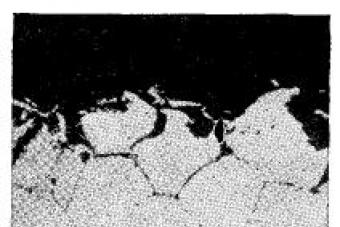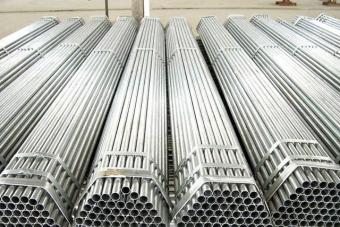The laborious process of forming the foundation can be facilitated by resorting to arranging a columnar structure. The conditions for installing pipes as a support and situations when the practical method is unacceptable, we consider in detail. Studying the features of building a foundation on the basis of pipes from different materials will allow you to decide on the appropriate method.
The nuances of arranging a column foundation
The idea to build the foundation of a house columnar of pipes is very attractive from the point of view of practicality. This method is less costly in terms of finance and manpower, you can do without involving special equipment and work in stages. The use of an economical option is possible subject to the construction of a light building. Among the restrictions on the arrangement of the columnar support structure, a height difference exceeding 2 m and a problematic geological situation where there is a risk of formation displacement are distinguished.
The depth of the foundation varies depending on the properties of the soil and the total mass of the future structure. Pillars from pipes are installed necessarily on the same level. This applies not only to the upper part of the supports, but also to the lower edge. The distribution of the grillage helps evenly distribute the load on the pipes of the columnar foundation. For wooden houses, a construction made of durable timber is more suitable, at the same time playing the role of a mortgage crown. If the columnar base is installed in an area with a low level of freezing of the soil as an alternative to a full-fledged strip foundation, the grillage is formed with a small depression in the ground.
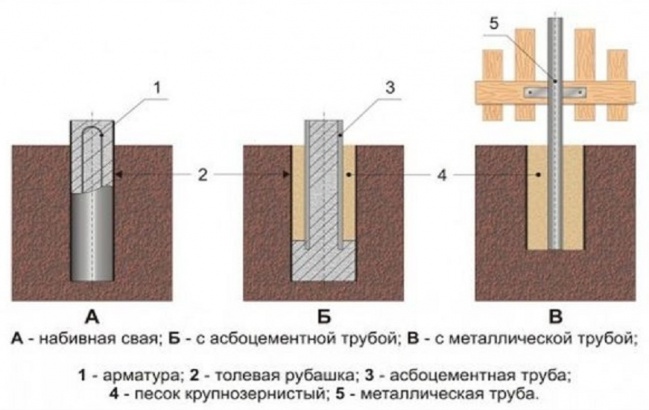
Characteristic features of the column foundation:
- Mandatory places for installing pipes: at the corners of the building, at the points of contact or intersection of partitions.
- The distance between the supports is 1.0-2.5 m and is calculated according to the results of determining the total mass of the future building.
- The gap between the soil and the high grillage for light structures is 40-80 cm.
- Often flooded soil requires the elevation of the columnar foundation above the ground to 1-2 m.
- The basement of the house made of pipes makes it impossible to equip the basement.
Comment! Areas where additional load is planned (stove or fireplace, porch or terrace) are equipped with local poles that do not have a connection with a common grillage.

Characteristics of supporting structures from various types of pipes
As a support for an easy construction, pipes from the following materials can be used:
- asbestos;
- plastic;
- metal;
- concrete and wooden poles are also used.
Advantages of the column design using asbestos pipes:
- there is no need to formwork, as is the case with concrete pillars;
- a trench, a pit and a sand and gravel pillow are not required;
- pipe installation is carried out without the participation of special equipment;
- the affordable cost of the material reduces the estimate of the cost of arranging the foundation.
Disadvantages of the columnar base:
- The significant weight of the future structure is an obstacle to the installation of pipes made of asbestos cement as supports.
- The period of operation of the material does not exceed 65 years.
- Pipe processing is carried out using protective equipment (respirator, goggles, etc.).

The column foundation of PVC pipes has the following advantages:
- material strength;
- not susceptible to corrosion processes;
- safety for human health.
Plastic as supports is suitable only for light structures (sheds, arbors and other outbuildings). The column foundation is formed from pipes designed for sewage.
Characteristic properties of metal supports:
- high degree of strength;
- not susceptible to cracking;
- quick installation.
Among the shortcomings, gradual destruction due to corrosion is noted, although this process is lengthy.

Design and preparatory work
For a columnar foundation, it is necessary to draw up a project, the following information will be required as initial parameters:
- the nature of the soil and the features of its behavior;
- soil freezing level;
- groundwater depth, probability of floods;
- precipitation in winter;
- the total mass of the superstructure, which is the sum of the weight of the material for walls, floors, roofs and other additional loads.
Focusing on the source data, determine:
- Depth of columnar foundation.
- The diameter of the pipe, which depends on the material used and the design load on the base.
- The number of poles and the frequency of their installation.
Advice! Supports should preferably be placed below the freezing line of the soil.

The arrangement of the column foundation begins with the marking of the area according to the design documentation. Wells for pipes are formed by a manual or gasoline drill. The drilling depth exceeds the freezing line of the soil by 30 cm, approximately this value is 150-180 cm. The diameter of the hole depends on the size of the pipe selected as a support for the columnar foundation. Poles should rise about 50 cm above the ground. Further actions depend on the type of pipe chosen.
The construction of the base of asbestos pipes
Asbestos-cement supports need additional reinforcement with reinforcing bars. The approximate dimensions of the column: height - 200 cm, diameter - 20 cm. After it is immersed in the well, actions develop along one of the paths:
- metal fittings are being installed;
- concrete mix is \u200b\u200bpoured.
The essence of arranging a column foundation in the first way:
- In the pipe, rods are installed at a distance of 6-7 cm from each other.
- The approximate length of the rods is 250 cm, they should be immersed in the ground and protrude outward from the pipe by 20 cm on each side.
- The upper part of the reinforcement is used for connection with the grillage.
- After the frame is designed, the pipes are poured with concrete mortar.
The drying of the column foundation lasts within one week.

The application of the second option is as follows:
- The support is poured with 1/3 concrete mixture.
- The pipe is raised by 10-15 cm so that the concrete at the base spreads, forming a sole for the columnar foundation.
- An important point is the same height of all raised supports. The reinforcement cage does not protrude beyond their edges.
- Further, the support is completely filled with concrete, a pin is fixed at the top, which rises by 30 cm and serves to connect the pipe and grillage.
Comment! If the soil under the columnar foundation has high flowability, before installing the supports, it is necessary to arrange a sand-gravel cushion, which must be covered with roofing material.
Preventing premature damage to reinforcing bars due to corrosion will help them to be treated with protective compounds.

Plastic support structure
As in the previous version, the process begins with leveling and marking the site for construction. Work is carried out using pegs and a thread or a rope.
The main stages of the formation of a columnar foundation with the use of sewer pipes:
- A trench is digging along the perimeter, in which the installation points of the supports are marked.
- The weight of the future structure and soil characteristics determine the interval between the posts, which should not exceed 2 m.
- Before installing a plastic pipe, a drainage cushion of gravel and sand is made at the bottom of the well. The waterproofing function is performed by polyethylene or roofing material.
- The recess is filled with a mixture of concrete and left for an hour to set the mortar.
- After the allotted period of time, a plastic pipe is being installed, which is pressed all the way.
- Further, reinforcing rods are installed inside the column, which protrude 20-25 cm beyond the edges.
The setting time of concrete in the column foundation lasts 6-8 days, depending on the ambient temperature.

Features of the use of metal pipes
The formation of the iron column structure also has two options. In the first case, the installation of supports is carried out 50 cm below the level of the drilled well. It is not important to choose a metal pole with a diameter of 20-25 cm, you can install two or three supports of smaller thickness. In this case, the gap between the pipes is up to 5 cm.
Important! A similar method involves the formation of a grillage using a steel profile that is welded to the pipe.
The proposed algorithm for arranging the column foundation is characterized by high reliability of fixation and provides the structure with maximum strength.
The second method requires the preliminary formation of a drainage cushion based on sand and gravel. The diameter of the pillars is 15-20 cm. Since the metal support should fit snugly against the walls of the well, when drilling its base decreases by several millimeters. The next step is to fill the pipe with a solution of cement and sand. If you plan to build above one floor, there is a need for additional strengthening of the column foundation with a reinforcing cage.
After five days, after the concrete has hardened, they proceed to the formation of a grillage. It can be made of wood, metal profile or in the form of a strip foundation. The choice depends on the severity of the entire structure.

Conclusion
The column foundation is a reliable support structure for light structures. If the weight of the building is increased, additional reinforcement measures should be provided to ensure strength.
Building technology is constantly evolving. New techniques are emerging based on new ideas and new opportunities. One of these new building technologies is the metal foundation.
The main idea is that steel piles and steel beams are used as load-bearing elements. The foundation of steel elements (see Fig. 1) is interesting for the simplicity of its design, ease of installation. When building a small house, such a foundation is one of the best solutions that are technically available today.
Fig. 1. Metal foundation
The construction of a metal foundation
The metal foundation does not require the time-consuming operations that are necessary in the construction of the “standard” foundation: there is no need to dig tons of soil, compact the remaining soil, add, formwork (and metal formwork for the foundation itself is not cheap). Naturally, a metal foundation is being built much faster. It is also important that such a foundation can be erected even in winter.
As supporting elements, piles are used, driven into contact with the bearing layers of the soil. Most often, piles are made of steel pipes, they are driven to a depth of 4-6 meters. To simplify the installation of support piles and improve the accuracy of their positioning, drilling is carried out in the required places. This is especially true for areas with rocky soil, where a traditionally driven pile can meet a hard obstacle. It should be borne in mind that pipes under the foundation should have a slightly larger diameter than the diameter of the drill (for better fixation of the pile by means of friction).
A beam structure is installed on top of the piles. Beams on the foundation, as a rule, make a box-like structure of steel channels. The connection between the beams lying in the same plane is provided by bolted joints or by welding. If, for aesthetic reasons, it is necessary that the foundation looks as natural as possible (looks like “normal”), then the channel is installed at ground level or even partially in the ground. However, the channel for the foundation must be carefully protected from corrosion, as in the near-earth zone, these processes develop quite intensively. Exposure to corrosion processes is one of the main disadvantages of such a foundation, because even high-quality processing at the construction stage will not be effective at constant humidity (proximity to groundwater, for example). And this means that after 10-15 years of operation, it may be necessary to conduct anti-corrosion treatment again. Given that the steel beams will be closed, their re-processing can cause some difficulties. If the corrosion protection is not carried out in time, the strength of the beams can critically decrease, the operation of the building will become impossible.
Asbestos pipe foundation
Another relatively new “foundation” technology is the columnar foundation of asbestos-cement pipes. The columnar foundation of such elements is notable for its low cost, low weight and speed of construction compared to the foundations of a standard design. And most importantly, such a foundation is not subject to corrosion due to the absence of steel in the external load-bearing elements.
Foundation work of asbestos-cement pipes begins with positioning, the so-called "Breakdowns" on the ground. The distance between two adjacent posts does not exceed 2 meters. If the plot is relatively flat, then pipes with a diameter of about 200 mm are used. With a significant height difference (500mm or more along the length of the house), the diameter of the supporting pipes should be at least 250mm.

Fig. 2. Asbestos pipe foundation
The following are drilling operations. The diameter of the drill is selected 50-100 mm larger than the diameter of the pipe. The depth of the holes should be about 1 meter (you need to drill below the freezing depth). Asbestos pipes for the foundation are installed according to the level, the voids between the pipe and the surrounding soil are filled with sand, compacted. In the center of the pipe, at a distance of about 70 mm from each other, we drive in two pieces of building reinforcement (see Fig. 2). The edges of the reinforcement must not protrude from the pipe. After that, we fill the inner cavity of the pipe with concrete. A stud about 0.4 m long with a threaded portion protruding outward is inserted into fresh concrete. A nut can be screwed onto the end of the stud recessed in concrete for better contact. The hairpin will be a mortgage element for the subsequent fixation of the beam. Further installation work is carried out after seven to nine days, when the concrete completely hardens. At the end of the work, it is necessary to fill the area under the future house with gravel. This will prevent grass growth (which is considered fire hazardous) and soil erosion.
For those who are going to start building their own home, sooner or later the question will become which type of foundation is best to choose. Of course, those who call the construction team and have enough financial resources for this will not puzzle how to save on building a house.
Those people who are limited in financial resources will probably think about how to make a solid foundation with their own hands, which in addition will be cheaper and more reliable. Such is the columnar foundation of pipes, and which will be discussed in this publication.
The benefits of a column foundation
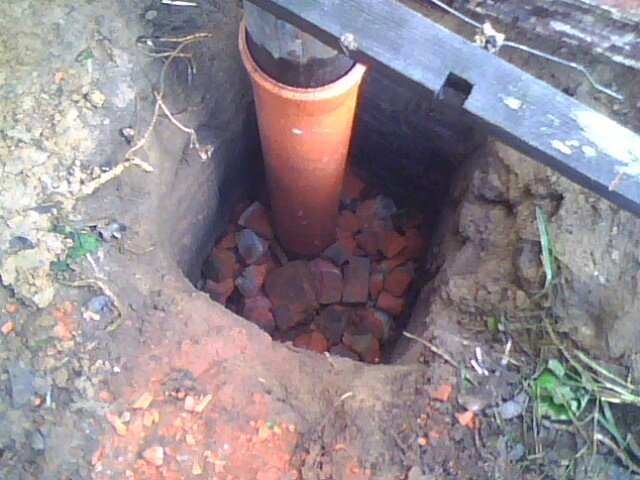
The columnar foundation, in spite of the fact that it occupies a separate place in the hierarchy of foundations, is somewhat similar to the pile one. This is due to the fact that both types (poles and piles) are dug into the ground and hold the general structure of the house or structure.
To strengthen them, sometimes they use a special screed, or a monolithic type of foundation, depending on the properties of the soil in the area where the construction takes place.
Its main advantages are as follows:
- such a base can be used on the most difficult relief areas (slopes, irregularities that cannot be aligned);
- due to the fact that the pillars dig into the ground below the level of freezing, they are not subject to shrinkage and other adverse moments;
- when it is created, it is not necessary to spend a large amount of funds, making a large amount of earthwork and construction work, so we can conclude that this type of foundation is ideal for those who are limited in financial resources;
- such a foundation is simply not replaceable if construction is planned on those sections of the terrain that are constantly being flooded, or ground water is located on them close to the surface;
- this type of foundation is a godsend for those who are going to build a house in which there will be a basement, since the columnar construction of the foundation is suitable for such buildings;
- the last advantage of this foundation is that it can be easily done with your own hands attracting a minimum number of people, as well as spending less financial resources.
But, despite the presence of so many advantages, it is necessary to point out some disadvantages. They consist in the fact that this type of foundation is not suitable for powerful structures and heavy structures.
If you plan to build a capital and heavy structure, it is better to combine the pillars together with a monolithic slab.
As mentioned above, we will talk about a columnar foundation, which is easy to do with your own hands. Experts recommend such a base made of pipes. Based on this, three varieties can be distinguished:
- column foundation of plastic pipes;
- columnar foundation of asbestos pipes;
- column foundation using metal pipes.
Each of them is easy to do with your own hands, and this will be discussed.
Column foundation made of plastic pipes

In order to create such a foundation with your own hands, you do not need to attract specialists, but you just need to carefully read the step-by-step instructions, which consists of the following actions.

As you can see, making such a foundation with your own hands is quite easy, the main thing is to use the above step-by-step instructions.
DIY asbestos pipe base
![]()
Asbestos pipes are also an excellent material for the manufacture of columnar foundations. Their feature is that they are made from materials such as asbestos fibers and cement.
When choosing a foundation for a future building, it is necessary to take into account the advantages of the chosen design: stability, resistance to moving soils, strength. However, such qualities as the cost of the material and the possibility of independent construction play a large role. To save the family budget, you can build a tubular foundation with your own hands, but even a simple and affordable option requires theoretical training and groundwork skills.
Methods for strengthening asbestos, metal or plastic pipes in the ground have some differences
Advantages of a pipe foundation
The tubular foundation is a kind of pile construction, the construction of which does not use concrete blocks, poles or beams, and not wooden supports, but various types of pipes - metal, plastic or asbestos. Novice builders prefer the point option because of the ease of translating the project into reality, while more experienced ones like a modest estimate and quickly achieve results.

One of the options for installing in the soil pipes with a diameter of 200 mm
Non-professionals who have already had to deal with the installation of a pipe foundation, highlight the following advantages:
- land work is minimized - there is no need for a large foundation pit or perfectly leveled site;
- laying takes a short period of time, after which you can start building a house (a week is enough for aging, while the strip foundation "ripens" 3-4 weeks);
- laying communications does not cause difficulties;
- the building is protected from possible flooding, since the count of supports is elevated above the ground.

The height above ground level depends on the type and size of the building
If we roughly calculate the amount of material and the cost of construction work (services of a brigade of workers), we will see that the tape construction will cost twice as much. Metal or plastic pipes for the pile foundation, a land drill, a concrete mixer - these are perhaps the most expensive points of the project. A hand tool, necessary for the construction of formwork, is in every home.

The scheme of the foundation device on screw piles
Do-it-yourself tubular foundation construction
Before starting excavation, you should reflect the plan of the future structure on paper, make detailed calculations, study the site and make markings. The main factors directly related to the foundation are the supports themselves (their number, type, intervals between them), the depth of the pits, soil characteristics, ground load, the presence or absence of groundwater, and the height of the structure above ground level.

An approximate scheme for creating a buried tubular foundation
Plastic pipe construction
When choosing plastic pipes for a column foundation, we focus on more durable products designed for external sewage. They are easily recognizable by the brick-orange color, while the products for interior use are gray. Manufacturers give a guarantee of 45-50 years, but if you reinforce the formwork with reinforcement or frame, the supports will last 20 years longer.

Pipes for external sewage are different in color and technical characteristics
PVC pipes for external sewage have a set of characteristics that are valuable for earthwork and building construction under heavy load:
- easily tolerate low temperatures, which allows them to be used in mid-latitudes and in the north;
- resistant to external aggressive effects (chemical and mechanical);
- despite the strength of the material, they are light weight;
- thanks to a smooth surface, soil motions are better tolerated.
Depending on the area and height of the building, we determine the optimal parameters of the pipes: length (from 1000 mm to 6000 mm) and diameter (from 110 mm to 630 mm).
Work order:
- We make a foundation project from pvc pipes, taking into account the nuances of building with your own hands, not forgetting about the number of supports, the intervals between them, the depth of the pits.
- We prepare the main material - plastic blanks for formwork. In order for the supports to acquire additional strength and stability, in the lower part it is necessary to make a broadening, the so-called “heel” - we take a black dense garbage bag and fix it with tape.
- In advance we weld the frame from the reinforcement for each support, we prepare the studs for fastening the lower harness from the beam (the stud will “peek out” from the concrete pouring).
- We drill holes exactly according to the marking so that the lower part of the supports is below the freezing level.
- We insert the PVC blanks into the wells, concreting the broadening. We observe the general level of height, for this we use a stretched building cord. A second option is also possible - cutting blanks at one level after installation.
- We reinforce the formwork with pre-prepared reinforcement frames.
- The final stage - we fill each pillar with concrete. In the upper part we fix the hairpin.
To increase the service life and protect the supports from destruction, the upper part, towering above the ground, is treated with bituminous mastic or covered with roofing material.
Metal supports
The main advantage of the foundation of metal pipes is its durability. Unlike plastic and asbestos analogues, steel piles will stand idle for more than one hundred years, but with the only condition - if the correct anti-corrosion treatment of the supports along the entire length is carried out. Another drawback is the high price of products, but it justifies itself if you are building not a utility room for tools, but a country house for temporary or permanent residence.

Construction of a frame house on a tubular foundation
Metal is not as easy to process as asbestos or polyvinyl chloride, so when driving piles you need to monitor the level. With inaccurate compliance with the specified height, it will be necessary to file steel supports, and this will take a lot of time and effort.
There are two ways to install metal supports:
- Simultaneous concrete pouring of pipes and pits (a section located inside the perimeter of the foundation). To comply with the horizontal and increase strength, use a metal frame that connects all the supports - grillage. For welding grillage, a galvanized steel profile is suitable.
- The use of double pipes - first they drive a base of a larger diameter, load bearing supports are inserted into it, then they are poured with concrete. This method protects against metal deformation, which is possible in the hot season.
If the foundation is being prepared for the construction of a residential building and the arrangement of communications is required, it must be remembered that the sealing of the glands during the passage of pipes through the foundations, the cellars of the cellars is governed by the standards of state estimated norms.
Combined asbestos cement foundation
Asbestos cement, along with metal supports, is used to arrange a columnar foundation from pipes. It is proved that combined structures are much stronger than point supports, therefore, concrete tape is used as additional protection. Formwork is constructed in the usual way from sheet metal, wooden boards or sheets of plywood.
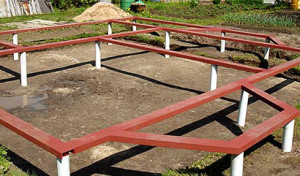
Asbestos-cement or metal pipes are connected by a grillage from a corner or profile
The main thing when pouring concrete is waterproofing the inside and the absence of cracks and cracks. It is worth abandoning the strip foundation if the construction is carried out on moving soils, since additional concrete pouring can cause the destruction of the entire structure as a whole.
Thematic video
Video: Foundation on screw piles
With the simplicity and ease of erection, structures of a tubular type are not always used. For example, they are relevant when it is planned to build a small wooden structure in area, and for a stone cottage with an increased bearing load, a strip foundation is preferable.
Video: Pile-screw foundations
Due to the raised open structure and the lack of a pit, there is a difficulty in building a cellar or basement. In areas with variable heights or with moving soil, another type of structure should also be chosen.
The foundation of any structure is the foundation, the structure on which the building rests, transfers its weight to the underlying soil and therefore is one of its most important elements. The most popular type, in terms of its simplicity and cost-effectiveness, is columnar.
Depending on the materials used, columnar foundations can be as follows: brick; concrete - monolithic or from finished blocks; wooden; from a metal profile; from pipes: asbestos-cement, plastic, metal. From the whole variety of columnar structures, one can distinguish the foundation from steel pipes, which is often used in the construction of single-story buildings and few critical buildings - garages, pantries, sheds, large arbors, grill houses.
It is a field of pillars located in the corners of the building, at the intersection of the outer walls and supporting partitions. The recommended pipe pitch is 1.5-3.0 m, depending on the weight of the building. Such structures are successfully used in areas with a slope and during construction on soft soils and can be built with your own hands.

The main advantages of the pipe foundation are high load-bearing capacity, the absence of deformations when observing the device technology, large earthworks are not required, a short construction period and low cost, because it does not require the use of complex construction equipment for digging a foundation pit and planning the territory and its can do it yourself. In addition, such a foundation will require a small amount of reinforcement and concrete.
Subject to technology, the foundation quickly gains the necessary strength and has a long service life. The advantages of the foundation of pipes include the possibility of its installation in flooded and moist areas. In addition, the supply of communications to such buildings is quite simple.
The disadvantages of such a foundation include:
- relatively low bearing capacity and, as a result, limited use;
- the need for floor insulation during the operation of the building in the cold season;
- the impossibility of building a basement; inability to use in areas with a large slope.
Piles of 2-3 pipes of smaller diameter are possible, which are installed at a distance of about 5 cm from each other.
Consider the sequence of the device foundation from the pipes with your own hands.
Preparatory work
For the proper construction of the foundation, it is necessary to take into account the following parameters: the depth of freezing of the soil at the construction site, the presence and depth of groundwater, soil characteristics, the total weight of the building.
 Pipes with a diameter of 250 mm
Pipes with a diameter of 250 mm Then you should prepare tools and materials:
- motorcycle or hand drill;
- concrete mixer;
- welding machine;
- grinder, screwdriver;
- hammer;
- nails
- level;
- cement, brand not less than 400;
- sand;
- crushed stone or gravel;
- rebar with a diameter of 10 or 12 mm;
- boards for wooden grillage or formwork for concrete grillage;
- pipes D \u003d 250-300 mm;
- bitumen or bitumen mastic.
The site is marked, pegs are driven into the places of future wells, the recommended step is 1.5-3 m. Pipes are prepared: the length of the pipes should be half a meter longer than the depth of the well, the surface of the pipe and the bottom end are carefully coated with bitumen mastic or heated bitumen, which is recommended add 10% of working off to give more elasticity.
DIY foundation
 Using a manual or gasoline drill, wells are drilled to install pipes. The depth of the well, about half a meter below the depth of freezing of soil in a particular area (for the Moscow region take 1.8 m). Sand or gravel is poured into the well to create a drainage layer of 150-200 mm. Then the prepared pipes are immersed, with the help of a level and a long board, the horizontalness of the pile field is checked, if necessary, the pipes are cut with a grinder.
Using a manual or gasoline drill, wells are drilled to install pipes. The depth of the well, about half a meter below the depth of freezing of soil in a particular area (for the Moscow region take 1.8 m). Sand or gravel is poured into the well to create a drainage layer of 150-200 mm. Then the prepared pipes are immersed, with the help of a level and a long board, the horizontalness of the pile field is checked, if necessary, the pipes are cut with a grinder.
The internal volume of the pipes and in the presence of a gap between the walls of the pipe and the well, this space is filled with concrete with layer-by-layer baying. When constructing a building with a height of more than one floor, 3-4 rods of reinforcement should be placed in the pipe.
In 5-7 days after filling the pipes with concrete and the initial set of strength, we proceed to the next step of making the foundation of the building with our own hands - installation of the grillage. The grillage can be made of wooden bars, metal (channel or profile pipe) or concrete. Concrete - the most time-consuming, but more affordable for the device with your own hands. To make it, you need to install a wooden formwork 200-300 mm above the ground, 0.5 m wide, 0.3-0.5 m high. Watch a video on how to fill the foundation with pipes yourself.
Fittings are laid, it is advisable to weld individual rods to the pipes. The formwork is lined with a cellophane film inside to prevent leakage of cement milk. Formwork in layers, filled with concrete with bayonet. After 5-7 days, the formwork can be removed. The foundation is ready for the construction of a house or any outbuilding.
The foundation of steel pipes is the most common design and available for the device with your own hands, has a high bearing capacity and low cost. Also, its advantage is that it is suitable for use in flooded areas.




